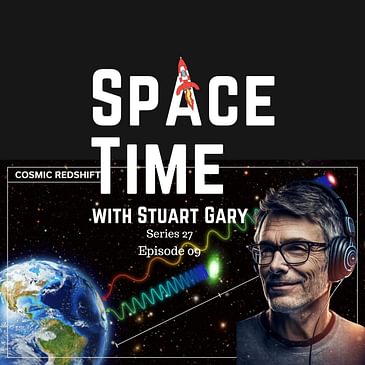SpaceTime Series 27 Episode 9
*The Dark Energy Survey’s unique insights into the expansion of the universe In 1998, astrophysicists discovered that the universe is expanding at an ever-accelerating rate. They attributed this to a mysterious force called dark energy
*Europe’s Einstein Probe lifts off on a mission to monitor the X-ray skies The European Space Agency, the Max Planck Institute and China have joined forces to launch the new Einstein X-ray space telescope into orbit.
*Using Earth’s magnetic field to understand key ancient historical events Archaeologists have used changes in Earth magnetic field to provide the most accurate yet dating techniques for archaeological finds.
*The Science Report
Autism linked to worse physical activity and sleep in kids
The complex family relationships of fairy wrens.
The bacteria that inhabit human ear piercings.
Skeptics guide what Jesus looked like
https://spacetimewithstuartgary.com https://bitesz.com
This week’s guests: Dr. Keith Bannister from the CSIRO Aaron Roodman Stanford Linear Accelerator Center Brian Nord Fermilab Ann Elliott Ohio State University And our regular guests: Alex Zaharov-Reutt from techadvice.life Tim Mendham from Australian Skeptics
🌏 Get Our Exclusive NordVPN deal here ➼ https://nordvpn.com/stuartgary or use the checkout code STUARTGARY. It’s risk-free with Nord’s 30-day money-back guarantee! ✌
Listen to SpaceTime on your favorite podcast app with our universal listen link: https://spacetimewithstuartgary.com/listen and access show links via https://linktr.ee/biteszHQ
For more SpaceTime and show links: https://linktr.ee/biteszHQ
Your support is needed...
**Support SpaceTime with Stuart Gary: Be Part of Our Cosmic Journey!**
SpaceTime is fueled by passion, not big corporations or grants. We're on a mission to become 100% listener-supported, allowing us to focus solely on bringing you riveting space stories without the interruption of ads. 🌌
**Here's where you shine:**
Help us soar to our goal of 1,000 subscribers! Whether it's just $1 or more, every contribution propels us closer to a universe of ad-free content.
**Elevate Your Experience:**
By joining our cosmic family at the $5 tier, you'll unlock: - Over 350 commercial-free, triple episode editions. - Exclusive extended interviews. - Early access to new episodes every Monday.
Dive in with a month's free trial on Supercast and discover the universe of rewards waiting for you! 🌠 🚀
[Join the Journey with SpaceTime](https://bitesznetwork.supercast.tech/) 🌟 [Learn More About Us](https://spacetimewithstuartgary.com)
Together, let's explore the cosmos without limits!
#space #astronomy #science #news #podcast #spacetime #nasa #esa
Become a supporter of this podcast: https://www.spreaker.com/podcast/spacetime-with-stuart-gary--2458531/support.





